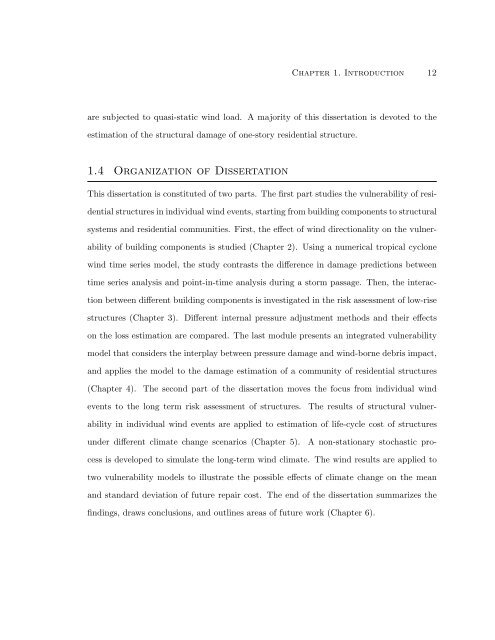Wind Hazard Risk Assessment and Management for Structures
Wind Hazard Risk Assessment and Management for Structures
Wind Hazard Risk Assessment and Management for Structures
You also want an ePaper? Increase the reach of your titles
YUMPU automatically turns print PDFs into web optimized ePapers that Google loves.
Chapter 1. Introduction 12<br />
are subjected to quasi-static wind load. A majority of this dissertation is devoted to the<br />
estimation of the structural damage of one-story residential structure.<br />
1.4 Organization of Dissertation<br />
This dissertation is constituted of two parts. The first part studies the vulnerability of resi-<br />
dential structures in individual wind events, starting from building components to structural<br />
systems <strong>and</strong> residential communities. First, the effect of wind directionality on the vulner-<br />
ability of building components is studied (Chapter 2). Using a numerical tropical cyclone<br />
wind time series model, the study contrasts the difference in damage predictions between<br />
time series analysis <strong>and</strong> point-in-time analysis during a storm passage. Then, the interac-<br />
tion between different building components is investigated in the risk assessment of low-rise<br />
structures (Chapter 3). Different internal pressure adjustment methods <strong>and</strong> their effects<br />
on the loss estimation are compared. The last module presents an integrated vulnerability<br />
model that considers the interplay between pressure damage <strong>and</strong> wind-borne debris impact,<br />
<strong>and</strong> applies the model to the damage estimation of a community of residential structures<br />
(Chapter 4). The second part of the dissertation moves the focus from individual wind<br />
events to the long term risk assessment of structures. The results of structural vulner-<br />
ability in individual wind events are applied to estimation of life-cycle cost of structures<br />
under different climate change scenarios (Chapter 5). A non-stationary stochastic pro-<br />
cess is developed to simulate the long-term wind climate. The wind results are applied to<br />
two vulnerability models to illustrate the possible effects of climate change on the mean<br />
<strong>and</strong> st<strong>and</strong>ard deviation of future repair cost. The end of the dissertation summarizes the<br />
findings, draws conclusions, <strong>and</strong> outlines areas of future work (Chapter 6).
















